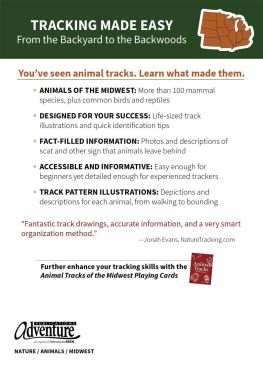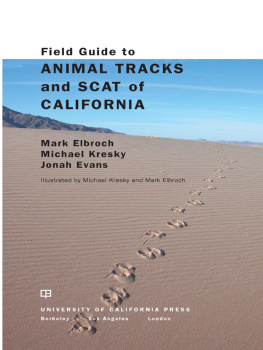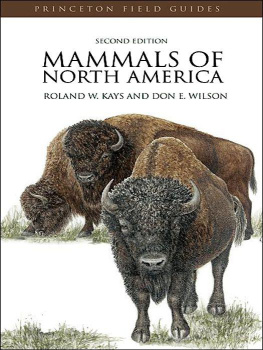

Acknowledgments
Wildlife tracking can sometimes look like a solitary endeavorthe lone naturalist in the field, studying tracks and sign. It is true that to get good at tracking one needs to spend considerable time in the field, often alone. But to get really good at tracking, one needs to learn together with others. Like all sciences, wildlife tracking is a collective enterprise, even when it appears individual. As Dr. Mark Elbroch likes to say, tracking takes more than a lifetime to learn.
I have done my best in this book to gather and present information that will be helpful to everyone who is interested in learning to identify and interpret animal tracks across the Midwest and beyondbut the knowledge I share here does not belong to me. It is the product of many lifetimes of work by countless biologists, naturalists, trackers, and educators, to whom I am deeply indebted. A warm thank-you to the community of instructors and evaluators at Tracker Certification North America, especially Dr. Mark Elbroch, Dr. Kersey Lawrence, Nate Harvey, Casey McFarland, David Moskowitz, Michelle Peziol, George Leoniak, and Marcus Reynerson, for their support of me in my own journey as a tracker and their tremendous contributions to the science of wildlife tracking. Thanks also to the members and supporters of the Minnesota Wildlife Tracking Project: Donnie, Kirsten, Rob, Amy, Brian, Bill, Mike, Sydney, Eric, Blake, Marty, Terry, Kathy, and so many more, who have spent years field-testing the first edition of this guide and pushing me to be a better tracker. I am grateful to the community of trackers on iNaturalist, particularly Kim Cabrera and Jonah Evans, for building a community and generously sharing their knowledge and experience. Special thanks also to colleagues Amy Beal, Jonathan Shapiro, Dr. Caitlin Potter, Nick Sharp, and Sue Mansfield; to my first tracking teachers, Tom Brown Jr. and Jon Young; to Julie Martinez and Bruce Wilson for their excellent illustrations; and to Brett Ortler and the staff at Adventure Publications.
Illustrations by Julie Martinez, Bruce Wilson, and Jonathan Poppele
Cover and book design by Jonathan Norberg
Edited by Brett Ortler and Ritchey Halphen
Photo credits on
10 9 8 7 6 5 4 3 2 1
Animal Tracks of the Midwest: Easy-to-Use Guide with 90 Track Illustrations
First edition, 2012; second edition, 2022
Copyright 2012 and 2022 by Jonathan Poppele
Published by Adventure Publications
An imprint of AdventureKEEN
310 Garfield Street South
Cambridge, Minnesota 55008
(800) 678-7006
www.adventurepublications.net
All rights reserved
Printed in the United States of America
ISBN 978-1-59193-574-2 (pbk.); ISBN 978-1-64755-034-9 (ebook)
Table of Contents
About This Guide
Go for a walk in the woods, or even at a local park, and you are likely to see a tremendous variety of birds, flowering plants, and trees. Go to a lake and you may see an abundance of fish swimming in the shallows or lined up on an anglers stringer. Yet except for a few species well adapted to human development, wild mammals tend to elude us. This may lead us to think that there are few mammals around. In fact, they are quite common, but they are often inconspicuous. Unlike birds, many mammals are primarily nocturnal or crepuscular, coming out only when the light is dim. Mammals are usually shades of brown and blend in with the ground. They are generally fairly quiet, relying on scent and sign to mark territories, rather than using songs and calls. The tracks and sign they leave behind are often our only indications that they are nearby. To get to know about the mammals of your area, you almost certainly must learn something about tracks. Tracking is a window into the lives of the secretive mammals that live around us.
What Is Tracking?
Tracking is the study and interpretation of the tracks (footprints) and other sign left behind by animals as they go about their lives. Tracking does not necessarily mean following a string of footprints to locate the animal that made them. It means understanding the footprints, scrapes, chews, digs, and scat (animal waste) that we inevitably run across when we are out in nature. Tracking begins with identifying the animal that left the tracks and sign behind for us to see. Over time, it grows into an intimate understanding of that animals life and the role it plays in the living systems of which we, too, are a part of.
Why Go Tracking?
Tracking may be the most ancient of all sciences. As a matter of survival, all of our distant ancestors learned to read animal tracks and sign. Today, tracking is a way for us to connect more deeply with nature. Tracking can help us feel that we are at home in the outdoors, and that we are part of an intimate conversation with the other animals that share our world.
It is easy to get started in tracking. Seeing a set of footprints in the snow or across a sandy beach awakens our natural curiosity. Like crime scene investigators, we try to piece together what happened from clues an animal left behind. What once looked like an empty woodlot or an abandoned streambank becomes a bustling bed of animal activitywith each crisscrossing trail telling a different animals story. Learning just a little bit about identifying tracks brings empty landscapes to life and can lead us on endless adventures.
No one ever completely masters tracking. It is possible to learn to accurately identify every tree or wildflower or bird that you see, but no one can identify every track or interpret every trail. There may be too few clues for even the best detectives to solve a particular mystery, and each mystery we solve leads us to even more mysteries. There is always more to learn, and there are always new mysteries being created.
This book will help you get out on the trail to solve some of those mysteries, and discover even more to engage your curiosity. Tracking is your invitation to a life of adventure and wonder.
Species Included in This Book
This book includes 70 entries filled with information about the tracks and sign of the more than 124 species of mammals, plus major groups of birds, reptiles, and amphibians found in the states of Illinois, Indiana, Iowa, Kansas, Kentucky, Michigan, Minnesota, Missouri, Nebraska, North Dakota, Ohio, South Dakota, and Wisconsin.
Not every species is discussed individually in this book. While there are noteworthy ecological differences among species, the tracks and sign of some are too similar to distinguish in the field. In this guide, birds, reptiles, amphibians, and many species of mammals, particularly small mammals, have been grouped together with other, similar species. For example, the 12 different species in the family Soricidae found in our region are grouped together here under the heading Shrews. In these cases, this book will help you identify the group of animals that could have left a particular set of tracks. Once you have identified the group to which a track belongs, you can use the detailed range, habitat, and behavioral information found in any good field guide to mammals to narrow the possibilities even further.
How This Book Is Organized
The individual accounts in this book are organized into groups based on similarities in tracks and typical track patterns. In most groups, there is a clear family resemblance among the tracks. Most groups mirror standard taxonomic divisions, while some include a variety of animals that are not closely related to one another. The groups are roughly organized from smaller to larger animals. Within each group, species are generally organized from smaller to larger track size.
Next page







